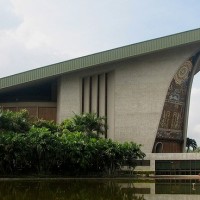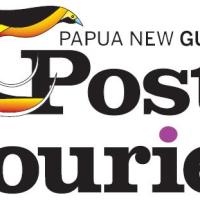Deep in the Perfumed Forests of Papua New Guinea

Introduction
A repeated sharp knocking sound interrupts the busy chirrups, trills and cackles of a million insects and birds deep in the steamy, dense rainforest of Papua New Guinea. The disturbance comes not from an exotic, newly-discovered woodpecker, but from a machete being brought down on its target by Tony, a local from the East Sepik village of Pukapuki.
In a land once famed for its fearsome head-hunters, it’s a relief to report that nowadays the machete-wielding hunters have recently found a rather different commodity to prize – agarwood.

Tony delivers a final blow, then holds aloft a rather unimpressive looking chunk of wood. It has been splintered from an equally unimposing tree – certainly unremarkable when compared to the towering forest that surrounds us. However, its discovery was greeted with great excitement.
But with the likes of gold, copper, oil and gas already discovered in Papua New Guinea (PNG), not to mention the vast timber resources, why is agarwood considered so important?
The Sweet Smell of Resin
“What makes it so valuable is its smell,” says WWF’s sustainable resource use trainer Leo Sunari.
“When these trees are injured or infected – maybe by certain insects, maybe by other means, we’re not too sure yet – they produce this dark resin in response.”
The resin’s long-lasting fragrance has made agarwood (also referred to as eaglewood and aloeswood, and more locally as gaharu) popular for thousands of years throughout Asia and the Middle East, where it’s used for cultural, religious and medicinal purposes, and as a perfume. Worldwide sources are now dwindling, so its discovery in PNG in 1997 spurred intense harvesting.
 “They were going crazy,” Leo recalls. “The trees were being chopped down and the roots dug up, because that’s where they thought the infection was most likely to be.”
“They were going crazy,” Leo recalls. “The trees were being chopped down and the roots dug up, because that’s where they thought the infection was most likely to be.”
To curb the rate of destruction, WWF has been working with local communities in PNG – who own about 97 per cent of the land – offering workshops to help them map their land, predict where the agarwood trees are, and develop ways of managing their resources sustainably.
“As part of that work, we’re teaching them how to extract the agarwood resin without killing the trees,” adds Leo. “And, we’re making sure they know its real value, so they’re not ripped off by traders.”
WWF is also helping communities designate certain regions as official wildlife management areas, which will help to protect them from being handed over as concessions to loggers and mining companies.
All in all, agarwood could provide a long-term sustainable livelihood for some of the poorest people in the country. It will also boost the survival prospects of the world’s third largest remaining rainforest and all the wonders it contains.
A Strange and Beautiful Land
Alfred Russel Wallace, the Victorian anthropologist and biologist who, along with Charles Darwin, hit upon the theory of natural selection, travelled to the equatorial island of New Guinea in 1858, describing it as “a country which contained more strange and new and beautiful natural objects than any other part of the globe”.
So far, I had been focusing – all too unsuccessfully – on avoiding much of this “strange and beautiful” fauna and flora, as I’d battled for three hours in the heat of the day somewhere in the province of East Sepik, in the north-west of the country. Razor-sharp fronds and spiny creepers reached from on high to snare me, and a maze of buttressed tree roots were hell-bent on tripping me up. Sloshing through countless streams resulted in a coating of leeches.
Now permitted a short breather, I take in some of the natural wealth for myself. New Guinea has more than its fair share of the stuff, much of it unique to the islands.

A huge butterfly flutters by me, like a massive leaf tumbling gently down, and it strikes me that this is truly a land of giants. The Queen Alexandra birdwing butterfly is the world’s largest, with a whopping 30cm wingspan. If lizards are your thing, the longest you’ll find anywhere is here – Salvadori’s monitor lizard, measuring in at 2.5m. And pigeon fanciers are in for a treat. Not only are these the biggest, but they also sport superb crowns of feathers.
Or if you’re after weird and wonderful, there’s a mammal that lays eggs – the long-beaked echidna (or giant spiny anteater) which, despite its alias, rather prefers juicy earthworms to ants. And PNG’s marsupials range from many types of kangaroo that have decided it’s better to live up in the trees, to the bronze quoll (or marsupial “cat”), which is the largest marsupial predator here.
Not that the quoll is very big. And, it’s precisely this lack of large predators that’s behind the incredible diversity of birds in New Guinea – 762 species were identified in a recent census. Most famous are its 38 of the world’s 42 species of birds of paradise. These extraordinary birds, with their fantastic courtship displays and resplendent plumage, were once considered too magical to be from this planet – it was thought instead that they hovered between heaven and earth.
Words From the Magistrate
After a long day’s hike through some of the country’s most inhospitable terrain, it’s time for a little more of the same before spending the night in a small shack, open on all sides to the elements. Tony wields his machete once more to construct a quick makeshift bed from a few vast palm leaves. His ease in using what the forest has to offer is a sign of how closely connected these people are with their environment.
It’s a theme I take up the next day with a Pukapuki elder, introduced to me simply as “The Magistrate”.
 “The forests are our lives,” says the Magistrate who has donned his traditional dress of feathers, flowers and shells, which highlight a close relationship with nature. “We rely on them not just for building materials, but also medicines, food and fuel.”
“The forests are our lives,” says the Magistrate who has donned his traditional dress of feathers, flowers and shells, which highlight a close relationship with nature. “We rely on them not just for building materials, but also medicines, food and fuel.”
Transportation too. Pukapuki, like most villages, is right next to a river. Here it’s the April River, a tributary of the mighty Sepik, one of PNG’s two most important waterways, which snakes 1,100km through the north of the country, and is considered the soul of the country. There are no roads in this region. To get around, villagers rely on long, thin canoes carved from tall trees.
“Today, we have to go much further to find good trees for making canoes, or to hunt for wild pigs, when before there were many nearby,” adds the Magistrate who has noticed the effects of resources being over-harvested during his lifetime.
The Next Generation
Sitting by a small fire, darkness has fallen almost in an instant, giving the insects their cue to beef up the noise to a deafening level. Above it all, I manage a few words with Bernard Sepani, 25, a local who is helping WWF to map local forest resources.
“Our needs are limited,” he says. “All we really need is just some money for education and healthcare.”
We’re interrupted by a huge insect buzzing around a lantern, which prompts Bernard to add lanterns and kerosene to the list of needs. He’d also like another water filter to safeguard the village freshwater supply. And, when pressed, dreams of an outboard motor for the dug-out canoe, which would improve transportation to neighbouring village markets.
It’s a far cry from the satellite TV and brick-built houses promised by some mining and logging companies in return for rights to their land.
 “That’s a real challenge, trying to convince communities that the sustainable approach is best in the long-term,” notes Ted Mamu, WWF’s conservation science coordinator in PNG. “People go with the wind. When loggers come with hard cash, why wouldn’t they go for that instead?”
“That’s a real challenge, trying to convince communities that the sustainable approach is best in the long-term,” notes Ted Mamu, WWF’s conservation science coordinator in PNG. “People go with the wind. When loggers come with hard cash, why wouldn’t they go for that instead?”
As well as our ongoing battle with international mining and logging companies, WWF is simply trying to formalize a process that’s been going on for centuries – allowing people to live in harmony with nature. That is why the global conservation organization is working to ensure there are plans in place that will enable them to continue to do so, despite the huge expected population increase, and pressures of development.
That night, the magistrate’s wife gives birth to their third child, a boy. When he is Bernard’s age, today’s new nurseries of agarwood trees may be mature enough to produce a steady supply of valuable incense, and along with it a strong income that will sustain his people.
In the meantime, there are great hopes for other sources of income – from cash crops to ecotourism, as well as for certified forest management. And, while it’s early days yet, the good news is that WWF is already hard at work here, in one of the very few places on Earth where there’s still an opportunity to save large areas of wilderness.
Gazing out into the darkness, I soak up the unforgettable sounds of PNG’s “strange and new and beautiful” nature, and find myself rooting for this land of wonders and its fabulous potential.
by Guy Jowett – Publications Editor at WWF-UK













